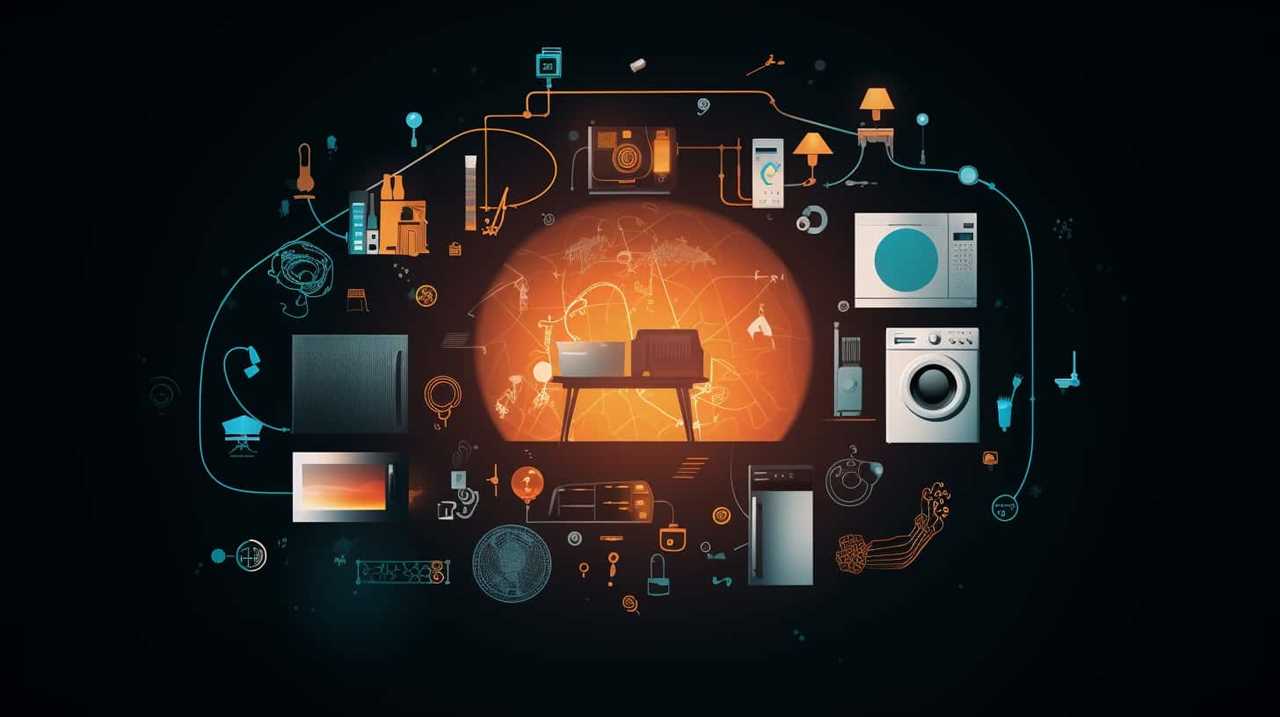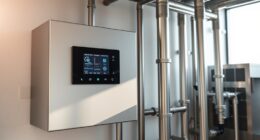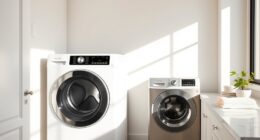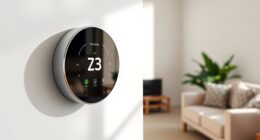Are you prepared to explore the realm of Japanese appliances?
Well, buckle up because we’re about to take you on a technical journey!
In this article, we’ll explore the compatibility of Japanese appliances in the US.
From voltage differences to plug types and power conversion, we’ll cover it all.

So, if you’re itching to know if that fancy Japanese gadget will work in your American home, stick around because we’ve got all the answers you need.
Let’s get started!
Key Takeaways
- Japanese appliances have a standard voltage of 100 volts, while the US has 120 volts, which can cause compatibility issues.
- Plug adapters can be used to convert Japanese plugs to US plugs, but compatibility does not guarantee voltage conversion.
- The frequency difference between Japan and the US (50Hz vs 60Hz) can affect appliance performance, especially for precise timing or motor-driven appliances.
- It is important to use power adapters specifically designed for Japanese appliances, check for product certification and safety labels, and ensure proper grounding to prevent damage and safety hazards.
Voltage Compatibility
Our research on voltage compatibility has shown that Japanese appliances may not work in the US due to differences in voltage levels. In Japan, the standard voltage is 100 volts, while in the US it’s 120 volts. This variance can pose a problem for Japanese appliances when used in the US, as they may not receive enough power to function properly.
To address this issue, it’s crucial to consider plug compatibility and safety precautions. Japanese appliances typically come with a two-prong plug, which may not be compatible with the three-prong outlets commonly found in the US. Therefore, it’s important to use plug adapters or transformers to ensure a proper connection.

Additionally, safety precautions such as checking the appliance’s voltage requirements and using surge protectors can help prevent damage and ensure the safety of both the appliance and the user.
Plug Types
Now let’s turn our attention to the next crucial aspect of using Japanese appliances in the US: plug types.
When it comes to plug compatibility, one must consider two factors: adapter compatibility and voltage conversion.
Adapters are necessary to physically connect Japanese plugs to American outlets, but it’s important to make sure they’re compatible with the specific plug types used in Japan.

Additionally, voltage conversion may be required to ensure that the appliance operates safely and efficiently.
Adapter Compatibility
When using Japanese appliances in the US, it is important to consider the compatibility of plug types. Japanese appliances often come with different plug types that are not compatible with US electrical outlets. To address this issue, an adapter can be used to convert the Japanese plug to a US plug, allowing the appliance to be plugged into US outlets. However, it is crucial to note that adapter compatibility does not necessarily guarantee voltage conversion. Japanese appliances are designed to operate on a 100V electrical system, while the US operates on a 120V system. This voltage difference can potentially damage the appliance or cause it to malfunction. Therefore, in addition to using an adapter, it is essential to check if the Japanese appliance is compatible with the higher voltage in the US.
| Japanese Plug Type | US Plug Type |
|---|---|
| Type A | Type A |
| Type B | Type B |
| Type C | Type A or B |
| Type D | Type A or B |
| Type G | Type B |
Voltage Conversion
To continue the discussion on adapter compatibility, let’s delve into the topic of voltage conversion for Japanese appliances in the US. Voltage conversion is an important consideration when using appliances from different countries, as different countries often have different voltage standards. Here are some key points to keep in mind regarding voltage conversion:
- Japanese appliances typically operate on 100 volts, while the US operates on 120 volts.
- Using a voltage converter or transformer is necessary to ensure proper power usage and avoid damage to the appliance.
- It’s important to choose a voltage converter that can handle the power requirements of the appliance.
- Some appliances, such as laptops and smartphones, have built-in voltage converters and can be used without additional equipment.
- Always check the power labels on your appliances to determine if they’re compatible with the US voltage standards.
Understanding the voltage conversion requirements for Japanese appliances is crucial to ensure their safe and proper operation in the US.

Now, let’s move on to discussing the frequency differences between the two countries.
Frequency Differences
When considering whether Japanese appliances will work in the US, one important factor to consider is the difference in frequency between the two countries.
In Japan, the standard frequency is 50Hz, while in the US, it’s 60Hz. This difference can affect the performance and functionality of certain appliances, especially those that rely on precise timing or motors.
In order to ensure compatibility, it may be necessary to use voltage converters or seek out appliances specifically designed for use in the US.

Compatibility With US Voltage
In terms of compatibility with US voltage and frequency differences, we’ve found that Japanese appliances may require additional converters or transformers. This is because Japan operates on a different voltage and frequency system than the US. Here are some key points to consider:
- Voltage converters: Japanese appliances typically operate on 100 volts, while the US operates on 120 volts. A voltage converter can be used to adjust the voltage to match the requirements of the appliance.
- Power adapters: Japanese appliances often come with power adapters that can be used to plug them into US power outlets. These adapters typically convert the shape of the plug to fit the US socket.
- Transformer requirements: Some Japanese appliances, such as those with motors or heating elements, may also require a transformer to handle the differences in frequency. The US operates on a 60 Hz frequency, while Japan operates on a 50 Hz frequency.
- Compatibility labels: It’s important to check the compatibility labels on Japanese appliances before using them in the US. These labels will indicate whether the appliance can be used with US voltage and frequency.
- Consultation with experts: If you’re unsure about the compatibility of a specific Japanese appliance, it’s recommended to consult with experts or the manufacturer to ensure safe and proper usage in the US.
It is crucial to ensure that the voltage and frequency requirements of Japanese appliances are met in order to avoid damage to the appliance and potential safety hazards.
Need for Voltage Converters
Based on the compatibility with US voltage and frequency differences discussed earlier, our discussion now turns to the need for voltage converters due to frequency discrepancies. While Japanese appliances may be compatible with US voltage, the difference in frequency can pose a problem. In Japan, the standard frequency is 50 Hz, whereas in the US, it’s 60 Hz. This difference in frequency can affect the performance and accuracy of appliances that rely on precise timing, such as clocks and timers.
To address this issue, voltage converters with frequency conversion capabilities can be used. These converters not only adjust the voltage but also convert the frequency to match the requirements of the appliance. When considering voltage converter options, it’s important to take into account the specific voltage compatibility issues and ensure that the converter can handle the required frequency conversion as well.

In the next section, we’ll delve into the topic of power conversion and explore the different options available to ensure the proper functioning of Japanese appliances in the US.
Power Conversion
Although Japanese appliances may have different voltage requirements, we can easily convert the power to make them compatible with the US electrical system. Power conversion is a crucial step in ensuring the power adaptability and optimal appliance performance.
Here are some key points to consider:
- Voltage Transformers: These devices convert the voltage from the Japanese standard of 100 volts to the US standard of 120 volts.
- Wattage Capacity: It’s essential to check the wattage capacity of the voltage transformer to ensure it can handle the power requirements of the appliance.
- Frequency Compatibility: Japanese appliances typically operate on a 50Hz frequency, while the US uses 60Hz. Some appliances may be sensitive to this difference and may not work optimally.
- Plug Adapters: Japanese appliances have different plug types, so using a plug adapter is necessary to fit them into US outlets.
- Safety Precautions: It’s vital to follow safety guidelines when using voltage transformers and plug adapters to prevent electrical hazards.
Appliance Functionality
To ensure the functionality of Japanese appliances in the US, we need to consider their compatibility with US electrical systems and any potential limitations they may have. One of the key factors to consider is the power requirements of the appliance. Japanese appliances typically operate on a voltage of 100 volts, while the standard voltage in the US is 120 volts. This means that some Japanese appliances may not work properly or may be damaged if plugged directly into a US electrical outlet. To address this, a power converter or transformer can be used to adjust the voltage to the appropriate level. However, it’s important to note that not all appliances are compatible with power converters, so it’s crucial to check the appliance’s specifications and consult the manufacturer or a professional before making any adjustments.

| Appliance | Power Requirements (Japan) | Power Requirements (US) |
|---|---|---|
| Washing Machine | 100 volts | 120 volts |
| Refrigerator | 100 volts | 120 volts |
| Microwave Oven | 100 volts | 120 volts |
Considering appliance compatibility and power requirements is the first step in ensuring that Japanese appliances can function properly in the US. However, it’s also important to address safety considerations to prevent any accidents or damage.
Safety Considerations
Let’s address the safety considerations when using Japanese appliances in the US.
It’s crucial to understand the differences in voltage safety and electrical standards between the two countries.
Here are some important points to consider:

- Voltage Compatibility: Japanese appliances are designed to operate on 100 volts, while the US operates on 120 volts. This voltage difference can affect the performance and safety of the appliance.
- Power Adapters: To ensure compatibility, it’s important to use a power adapter specifically designed for Japanese appliances. This will help regulate the voltage and prevent damage to the appliance or electrical system.
- Frequency Difference: Japan uses a frequency of 50 Hz, whereas the US uses 60 Hz. Some appliances, such as clocks or motors, may not function properly due to this difference.
- Electrical Safety Standards: Japanese appliances may not comply with the electrical safety standards of the US. It’s crucial to check for product certification and safety labels before using them.
- Grounding: Japanese appliances may not have a grounding plug that’s common in the US. It’s important to ensure proper grounding to prevent electrical shocks and other safety hazards.
Adaptability Options
One option we’ve for adapting Japanese appliances to work in the US is to use voltage converters. These devices allow us to convert the voltage from the Japanese standard of 100 volts to the US standard of 120 volts.
However, there are some adaptability challenges that we need to consider. Firstly, not all appliances are compatible with voltage converters, especially those with complex electrical components. Additionally, voltage converters may not provide a stable power supply, which could lead to damage or malfunction of the appliance.
It’s important to carefully check the voltage requirements and compatibility of the appliance before using a voltage converter. Furthermore, it’s essential to comply with voltage regulations to ensure the safe and efficient operation of the appliance.
Voltage Transformers
When it comes to using Japanese appliances in the US, one of the key considerations is voltage compatibility.

Japanese appliances typically operate on a voltage of 100V, while the US standard is 120V. This means that simply using an adapter plug may not be enough to ensure proper functionality.
Voltage transformers can be used to convert the voltage from 120V to 100V, allowing Japanese appliances to work safely in the US. However, it’s important to note that using a voltage transformer may not be suitable for all appliances, as some may be sensitive to voltage fluctuations and could be damaged in the process.
Adapter Plug Compatibility
We need to consider the adapter plug compatibility and voltage transformers when using Japanese appliances in the US. It’s essential to ensure that the plug type of the Japanese appliance is compatible with the outlets in the US.
Here are some safety precautions to keep in mind:

- Check the plug type of the Japanese appliance and compare it with the US outlet to ensure compatibility.
- Use an adapter plug if the Japanese plug doesn’t fit into the US outlet.
- Ensure that the adapter plug is properly grounded to prevent electrical hazards.
- Avoid using multiple adapters or extension cords, as they can overload the electrical circuit.
- Always follow the manufacturer’s instructions and guidelines for using the adapter plug safely.
Considering these plug type compatibility and safety precautions is crucial to prevent electrical accidents and ensure the proper functioning of Japanese appliances in the US.
Now, let’s move on to discussing voltage conversion options.
Voltage Conversion Options
Now let’s explore our options for voltage conversion, using a suitable voltage transformer for Japanese appliances when using them in the US.
When it comes to voltage converter options, there are a few factors to consider. Firstly, you need to ensure that the voltage transformer you choose can handle the power requirements of your Japanese appliances. Look for a transformer with a wattage rating that matches or exceeds the total wattage of your appliances.

Secondly, it’s crucial to prioritize electrical safety precautions. Make sure to select a transformer with built-in surge protection and thermal overload protection to safeguard your appliances from power surges and overheating.
Additionally, consider the size and weight of the transformer for portability and ease of use.
Potential Appliance Damage
Our main concern is the potential damage that voltage transformers can cause to our appliances. While voltage transformers are necessary for converting the Japanese 100V electrical system to the American 120V system, they can sometimes have adverse effects on our appliances. Here are some potential issues to consider:
- Voltage fluctuations: Voltage transformers may not provide a stable output voltage, leading to fluctuations that can damage sensitive electronic components.
- Overheating: Inadequate voltage transformers may not be able to handle the power requirements of certain appliances, resulting in overheating and potential damage.
- Power surges: Voltage transformers may not have built-in surge protection, leaving our appliances vulnerable to sudden power spikes.
- Incompatibility: Some appliances may not be compatible with voltage transformers, causing them to malfunction or break down.
- Impact on appliance lifespan: The use of voltage transformers may shorten the lifespan of our appliances due to the stress they put on the electrical components.
Considering these potential risks, it’s crucial to weigh the potential repair costs and impact on appliance lifespan before using voltage transformers.

Transitioning into the subsequent section about ‘warranty and service’, it’s also important to understand the implications for warranty coverage and available service options.
Warranty and Service
Discussing warranty and service for Japanese appliances in the US, we found that the coverage and support provided vary depending on the manufacturer and the specific product. When it comes to warranty coverage, some Japanese appliance manufacturers offer limited warranties that only cover certain parts or components for a specific period of time. Others provide more comprehensive warranties that cover the entire appliance for a longer duration. As for service availability, it is important to note that not all Japanese appliance manufacturers have service centers or authorized repair technicians in the US. This means that in case of any issues or repairs, customers may have to rely on third-party repair services, which can be costly and time-consuming. To provide a clearer picture, here is a table showcasing the warranty coverage and service availability for a few popular Japanese appliance brands:
| Brand | Warranty Coverage | Service Availability |
|---|---|---|
| Sony | Limited | Authorized service centers available in major cities |
| Panasonic | Comprehensive | Authorized service centers available nationwide |
| Toshiba | Limited | Limited service centers available in select regions |
It is crucial for consumers to research and consider these factors before purchasing Japanese appliances in the US to ensure they have the necessary warranty coverage and service support.
Conclusion and Recommendations
Based on the warranty coverage and service availability discussed, it’s evident that careful consideration and research are necessary before purchasing Japanese appliances in the US. After conducting a thorough analysis, we’ve come to the following conclusion:

- Evaluate warranty coverage: Examine the terms and conditions of the warranty to ensure it provides sufficient protection for your investment.
- Research service options: Look into the availability of authorized service centers or technicians who specialize in Japanese appliances to ensure prompt and reliable repairs.
- Consider compatibility: Take into account the voltage and power requirements of the Japanese appliances and ensure they’re compatible with the US electrical system.
- Seek customer feedback: Read reviews and testimonials from other customers who’ve purchased and used Japanese appliances in the US to gain insights into their performance and reliability.
- Consult experts: Engage with professionals in the field who’ve experience with Japanese appliances to get their recommendations and guidance.
Frequently Asked Questions
Can I Use a Voltage Transformer to Convert the Voltage for My Japanese Appliances in the Us?
Using Japanese appliances with a voltage converter in the US can have pros and cons. It allows compatibility but may affect appliance performance. Potential risks include overheating or damage. Benefits are convenience and cost savings.
Are There Specific Safety Considerations I Need to Keep in Mind When Using Japanese Appliances in the Us?
When using Japanese appliances in the US, it’s important to consider potential compatibility issues and take safety precautions. We should be mindful of voltage differences, plug types, and the need for voltage converters or transformers.
What Adaptability Options Are Available for Japanese Appliances to Work in the Us?
Adaptability options for Japanese appliances in the US include voltage conversion devices. These devices can adjust the voltage to match the requirements of the appliance, ensuring compatibility and safe operation.
Does USing Japanese Appliances in the US Void the Warranty and Service Options?
Using Japanese appliances in the US may impact appliance performance and void the warranty and service options. Parts and repairs may also be more difficult to find.

What Are the Recommended Voltage Transformers for Japanese Appliances in the Us?
Recommended voltage transformers can help resolve compatibility issues between Japanese appliances and US power systems. It is crucial to consider the wattage and frequency requirements of the appliance to ensure proper functioning and avoid damage.
Conclusion
In conclusion, when determining if Japanese appliances will work in the US, it’s important to consider voltage compatibility, plug types, frequency differences, power conversion, and appliance functionality.
While adaptability options such as voltage transformers can help bridge the gap, it’s crucial to also consider warranty and service options.
By carefully considering these factors, individuals can ensure a smooth transition and optimal functionality for their Japanese appliances in the US.










